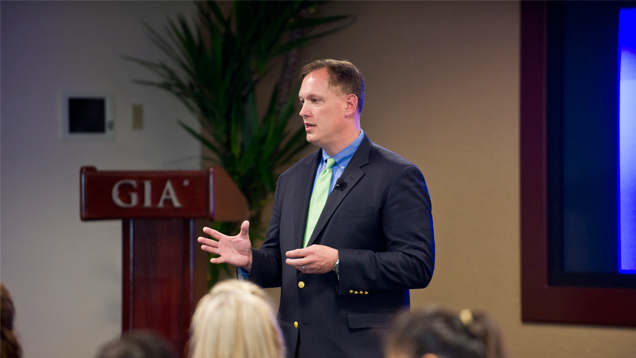GIA Reveals World of Gemstones to Crime Investigators
March 10, 2010

Their missions intersect when law enforcement uses GIA as a resource when they need to learn what to look for on the streets to recover stolen property. Over the past several years, several dozen crime fighters have met at GIA’s world headquarters in Carlsbad for a two-week crash course in gemology to do just that.
Investigators from countries including Brazil, Colombia, Belgium, India, Thailand, the UK and the UAE joined officials from the New York and Los Angeles police departments and FBI special agents from New York, Los Angeles, Miami and Washington, D.C.
The gemological knowledge they gained is priceless, according to Patrick Peys, a detective with the Belgium Federal Police.
“There is a big difference between being an operational police officer and having knowledge about the product you’re investigating,” he said. “That kind of basic information might give you an advantage you otherwise would not have.”
Investigators are exposed to a broad range of gemstone topics, including how to use gemological tools (loupes, tweezers, microscopes); the Four Cs of diamonds and what to look for in clarity, cut and color; synthetics, imitations and color treatments; the diamond industry and the Kimberley Process; field identification of colored stones; and how to read GIA grading reports.
“We don’t get a lot of highly technical training in the FBI,” said Daniel McCaffrey, of the New York field office. “It’s not that we’re called on every day to make identifications of diamonds in the field, but it’s that general know-how – and the impression that we know how – we convey to people in the industry that enables us to extract more information.”
GIA and domestic law enforcement officials, especially McCaffrey, have a long history of working together to solve gem crime, said Ivy Cutler, records coordinator for the GIA Laboratory in New York.
“Gems are one of the most concentrated forms of wealth and diamonds travel very quickly,” Cutler said. “It’s amazing how frequently the stolen diamonds flow back to GIA. The crime community is well-connected and the crooks are very smart. A lot of information moves through these criminal networks and the trade is largely unaware that they may be handling stolen goods.”
She says grading reports and inscriptions are one of the most effective ways to protect gemstones because the information is stored in GIA’s database for future reference, which has proved to be extremely useful for investigators. GIA created its database in the 1980s and has been adding to it ever since.
“It’s so significant to have this relationship with GIA and have a starting point,” McCaffrey said. “Literally hundreds and hundreds of stones have been recovered because of it.”
Beyond their relationships with GIA and what they learned about gemology, all of the investigators agreed that meeting each other was one of the best results of the two-week seminar.
“Diamond and jewelry criminals always work internationally,” Peys said. “You have to do the same to follow the crooks to get a hold of them. Following the ‘book’ and doing it in official ways takes too much time. I would call the presence of all of these people as important as the content of the course, because these guys are the ones we are going to try to contact to get some useful information. If you can build up such a network internationally, then you are doing an awesome job.”
“I’m very involved in diamond investigations and as far as I know, GIA is the only organization that is really doing something to bring law enforcement officers together to educate them and get that network working. For me, that’s very visionary,” Peys said.
Larry Wright, director of security for GIA, believes it is imperative for GIA and international law enforcement agencies to work together to solve the fast-moving reality of gem crimes.
“It’s a new world. We must communicate and coordinate across international boundaries and continents to fight against criminals who take advantage of the public.”
About the Author
Amanda J. Luke is a senior communications manager at GIA. She is the editor of the GIA Insider and Alum Connect and was the editor of The Loupe magazine.
.jpg)


